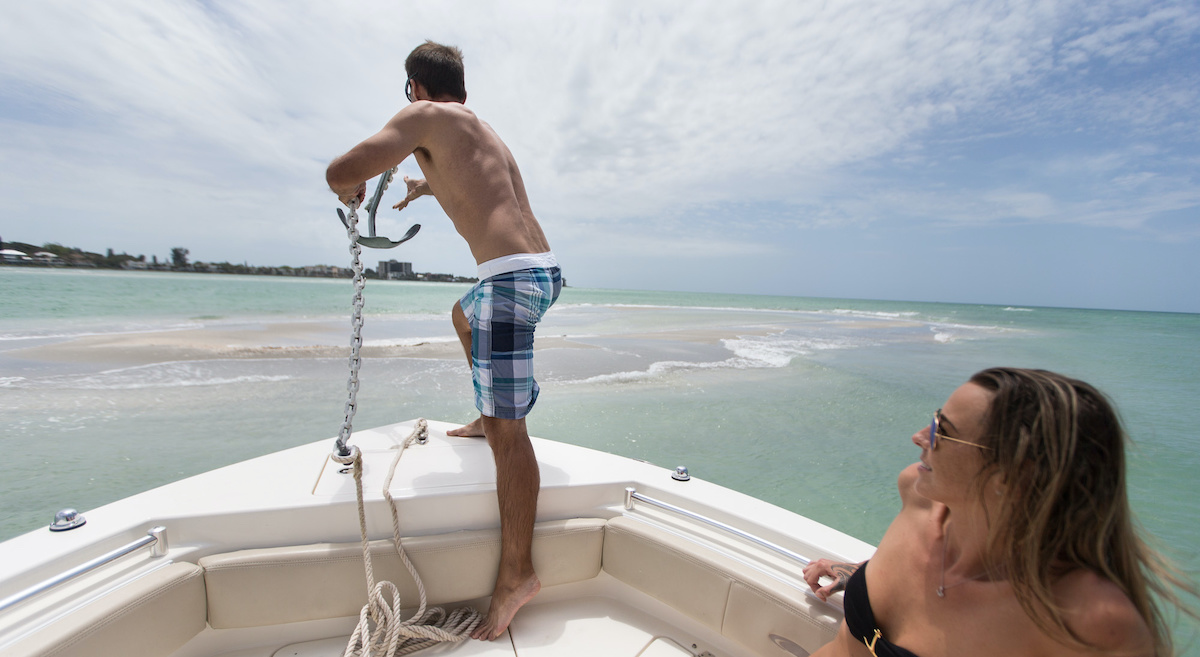Most new boats do not come equipped with an anchor, but every boat should have one on board. You may want to drop the anchor to hold the boat in a secluded cove for an afternoon of relaxation or even an overnight stay, or just to hold your boat over fishing structure.
The anchor is most important as a critical item of safety gear. If you should lose power, it’s the anchor that’s going to keep your boat from drifting into peril, be it rocks or another shoal, or the dangers of a surf-swept shoreline. The best anchor first depends on the size and type of your boat.
A tall sportfishing boat or power cruiser that can catch a lot of wind will need heavier gear, for example, then a low-profile bass boat. Boats used for long-distance cruising may need to anchor in rough weather, and on a variety of bottoms, and thus will need not only heavier gear but also several different anchors suitable for different bottom conditions.
How to Anchor a Boat: Step-by-Step Guide
Consult a Boat Anchor Size Chart
Anchor manufacturer guidance, usually based on boat length, can be a good starting point to determine which size anchor is appropriate for your boat. If your boat is heavier than typical boats of that length, or presents more windage, you should select a larger anchor.
The same logic applies if you frequent an area with high winds. Generally, the bigger the anchor, the better, but the anchor’s holding power in the bottom, rather than its weight, is what really matters. Always keep your ground tackle (the anchor and its rode, or line) ready to deploy at a moment’s notice.
Types of Boat Anchors
Once you have a better idea of what size anchor you need for your boat, you'll also want to consider the type of anchor. Let's explore some of the most popular options available for boaters when it comes to anchors.
Mushroom Anchor
Very large mushroom anchors are used for moorings or securing buoys. Small mushroom anchors may be effective in the softest river bottom but have minimal holding power. They should be used only for personal watercrafts, small aluminum fishing boats, or dinghies.
Danforth or Fluke Anchor
This style of anchor is a good choice for smaller boats because it folds flat and is easy to stow, and has great holding power for its weight. Its wide, sharp flukes sink into sand and hard-mud bottoms, but are less effective in deep mud or a grassy bottom. If the wind shifts and boat drifts over the anchor and then in the opposite direction from which it was set, a Danforth anchor can pull free.
Plow Anchor
A plow anchor is a little more cumbersome than a Danforth, and is a good choice if the anchor is secured on a bow roller rather than in an anchor locker in the boat. A plow anchor has a single penetrating point and is more likely to reset itself if boat position changes. It can be more effective than the Danforth in light grass, has the strength to hold in a rocky bottom if it gets a good grip, and does well in soft bottoms.
Claw Anchor
This non-folding anchor is similar to the plow anchor, but has a broader scoop shape that works well in mud, clay or sandy bottoms. These anchors are also strong enough to hold on a rocky bottom. A claw anchor will re-set quickly if the wind changes. It may not work well on a very hard bottom, or in thick vegetation, both challenging for all types of anchors. This anchor is also best-suited to installation with a bow roller or windlass.
Grapnel Anchor
Shaped like a grappling hook, this anchor has multiple tines or points, and is designed to grab onto structure on the bottom—such as rocks or submerged timber—rather than sink into the bottom. The tines usually fold up along the shank so that the anchor is more compact for stowage. On some models the tines are designed to bend to make it easier to retrieve the anchor if it becomes snagged on bottom structure. The tines can them be bent back into shape. Grapnel anchors are available in many sizes, including very small models for jon boats, skiffs or small boats, like kayaks.
Read Next: How to Tie Up a Boat: Mooring Guide
You May Also Like:
